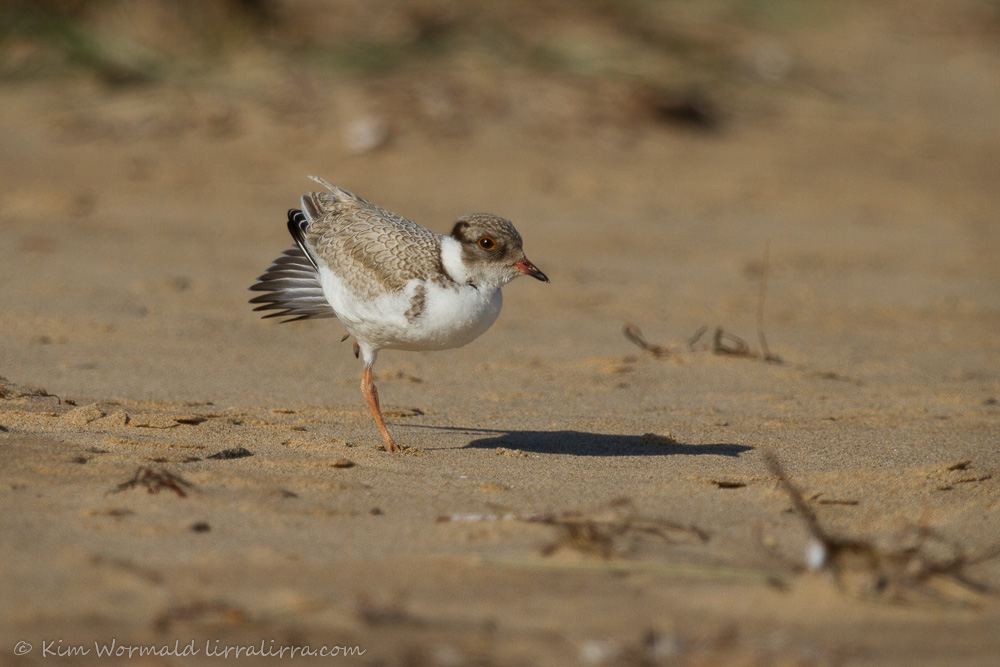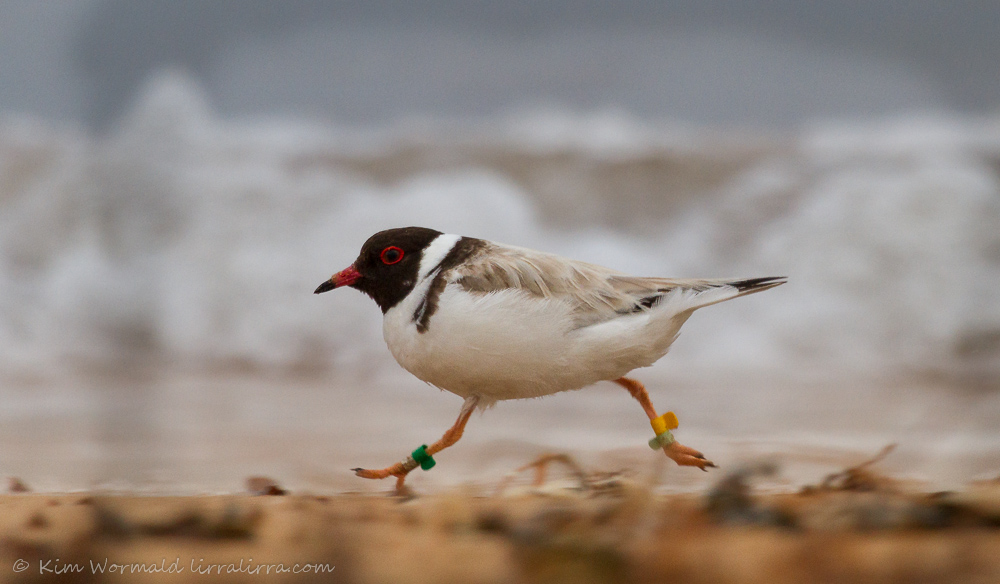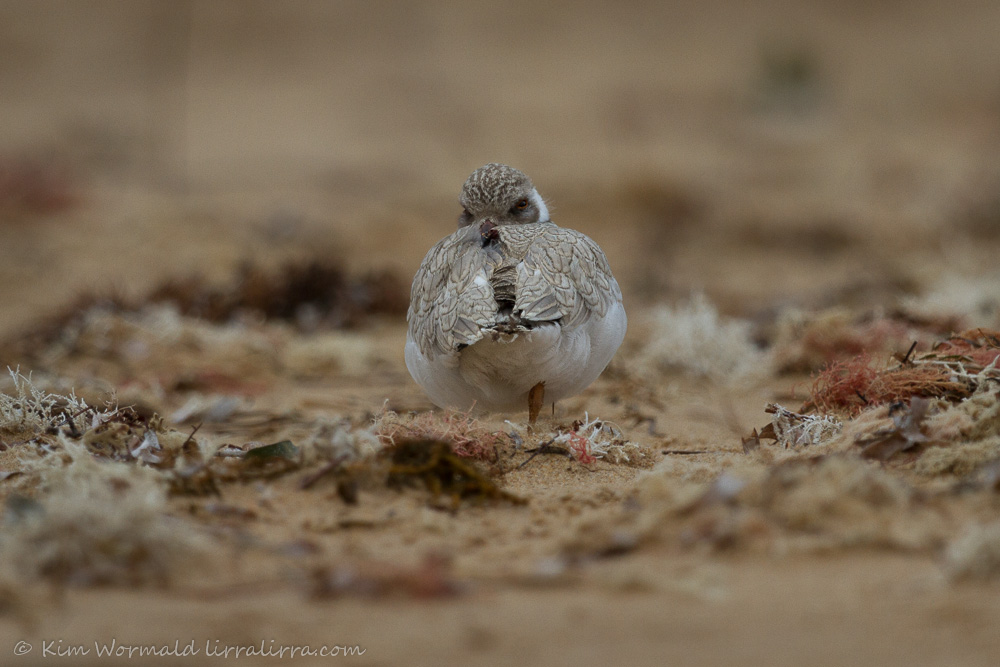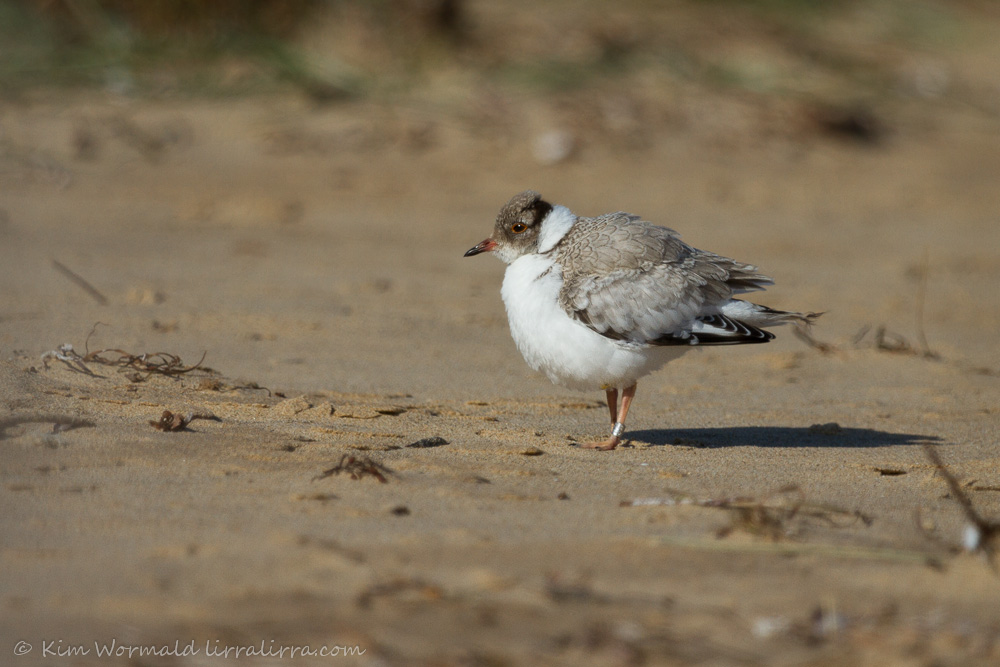Hooded Plovers are tiny, endangered shorebirds. They nest on beaches during summer, laying their eggs in shallow scrapes just above the high tide mark. Their eggs take 30 long days to hatch, their chicks feed themselves from day one and it’s 5 weeks before the chicks are strong enough to fly. That’s a total of 9 weeks that these exquisite little birds are vulnerable to dangers.
 Hooded Plover (Thinornis rubicollis) – chick
Hooded Plover (Thinornis rubicollis) – chick
Canon 7D, 100-400mm L IS USM
Over the past few weeks I’ve received updates on the development of three hoodie chicks at Phillip Island just south of Melbourne. I didn’t visit the chicks as I didn’t want to add to the human overload they would be experiencing at this time of year (I wish I had!). Last week the ranger asked if I’d join the local volunteers who are helping the parent birds protect their chicks. I contacted Sue, the inspirational volunteer coordinator and my first ‘shift’ was scheduled. I returned the following two mornings before sunrise and one evening before sunset but the magic light was obscured by clouds and photographing the chicks was challenging.
The above image was taken on the hoodie chick’s 5th week birthday but fledging, flight, was delayed by a few days as the three chicks were slightly underweight; this is possibly because of the number of times their foraging was interrupted by visitors to the beach.
 Hooded Plover – chicks
Hooded Plover – chicks
Canon 7D, 100-400mm L IS USM
Hooded Plover chicks are difficult to see when they are feeding at the water’s edge and almost impossible to see when they are resting or hiding. I’ve seen beach goers walk right past hoodies, oblivious of the tiny eyes watching them pass. The image above shows about 1 metre of beach and needed a very close look and a good lens to spot the bundles of feathers hiding amongst the seaweed. The chicks stand out more than they would to passersby because I was lying on the ground and using f/5.6 to blur the background.
 Hooded Plover – chick
Hooded Plover – chick
Canon 7D, 100-400mm L IS USM
I hadn’t realised how far I had commando-crawled along the beach until I saw 50 metres of strange tracks in the sand and realised that my knees and elbows were more skinned than they’ve been since I was ten years old. My elbows are still sore but it was worth every ‘ouch’ to have these exquisite birds within range and comfortable with my presence. The chicks occasionally stretched their wings in preparation for flight.
 Hooded Plover – adult
Hooded Plover – adult
Canon 7D, 100-400mm L IS USM
The hoodie above is the male, the father of the chicks, racing along the water’s edge. The parent birds are remarkably vigilant as they continually scan the beach for danger. They react to people and dogs by calling softly to their chicks and getting them to freeze or run depending on the threat. If they freeze they risk being stepped on, if they run they risk triggering a dog’s chase instinct. Chicks are very vulnerable until they are able to fly.
It was inspiring to see the dedication of the volunteers as they spoke to beach goers, asking if they’d walk close to the water’s edge to minimise disturbance to the hoodies and sharing information about the chicks’ development. Many locals and visitors have been following the chicks’ progress and were keen to pause and hear the latest updates. While I was there a group of young people spread their towels on the sand between the hoodies and the water; they were settling in by the time I spoke to them but willingly moved when they learned about the chicks. Dog owners were also mindful of the hoodies and ensured their dogs were leashed when in the area. What a lovely community!
Sadly I’ve noticed that a minority of dog owners on other beaches with nesting hoodies are not so willing to ensure their dogs are leashed, despite the signage. I believe in the intrinsic goodness of people and presume most of them don’t understand the devastating impact that roaming dogs can have on hoodie chicks. As a dog owner I love to see my dog running like the wind, it’s a beautiful sight, but there are plenty of other places I can take her and there are no other places that Hooded Plovers can raise their families. Last year a hoodie chick was killed, just days before it was due to fly, by an off-leash labrador. I may lose friends for saying this but I wish that a ‘No Dogs’ policy was enforced on beaches where hoodies are nesting, or preferably that sections of beaches are closed when nests are active, as happens in the USA to help protect the similarly endangered Piping Plovers.
 Hooded Plover – chick
Hooded Plover – chick
Canon 7D, 100-400mm L IS USM
I am always thrilled when birds are so comfortable with my presence that they preen themselves as I watch. This little chick busily buried its head amongst its feathers and pulled them through its beak before looking up to peek at my camera which was just inches above the ground.

Hooded Plover – chick
Canon 7D, 100-400mm, L IS USM
It’s amazing how fluffed this chick looked when it shook itself – what a beauty! If you are interested, more information and images can be found at Hooded Plovers and Miracle birds.
My heartfelt admiration goes to the team of volunteers who have spent the past two months monitoring the progress of these chicks, and to the wider community who took this exquisite hoodie family into their hearts. The team’s hard work resulted in all three chicks surviving, a wonderful result for this little family and for the plight of Hooded Plovers as they fight extinction.
Happy birding, Kim
NB It is possible to receive a weekly email informing you that lirralirra has been updated – just add your address to the ‘Subscribe to email’ box above right.
Also, I recently added a Facebook ‘like’ button. Thank you to all ‘likers’ – it’s great to know if you enjoyed your visit.

[…] Read more about the journey of these Hooded Plovers and beautiful photos from Kim Wormald at http://www.lirralirra.com […]
Kim, what a great post on the Hooded Plovers. They are so cute, I just love all the Plovers.. It is wonderful that the volunteers are there to help on the beaches. I think the No dogs allowed on the beach during the Plovers nesting and fledgling would be a good thing..I love my dog and I would not have a problem following rules to protect these endangered birds. Awesome photos, well done! Have a happy weekend!
It’s so good that you agree about the dogs. I find plovers very comical, I love the way they run along the beach in bursts. You have a good weekend too Eileen!
I whole heartedly agree to no dogs during nesting season! There are plenty of dog safe beaches, and it’s not hard to leash your dogs to save endangered wildlife. As a owner of 3 dogs I would be happy to avoid them! They are so sweet, beautiful photos as always!
That’s great Tamsin, your comment makes me very happy.
Oh Kim.
What a wonderful post. I am so happy that you and the other volunteers achieved such a stunning success. Long may it continue.
Beautiful images – and thank you so much for the blood you shed to get them. Happy tears here now.
The same pair of hoodies had three unsuccessful nests last year, the team of watchers did a wonderful job to help these little guys survive. I’m delighted that you enjoyed the post EC, and so funny re shedding blood for the images, my elbows are still sore!